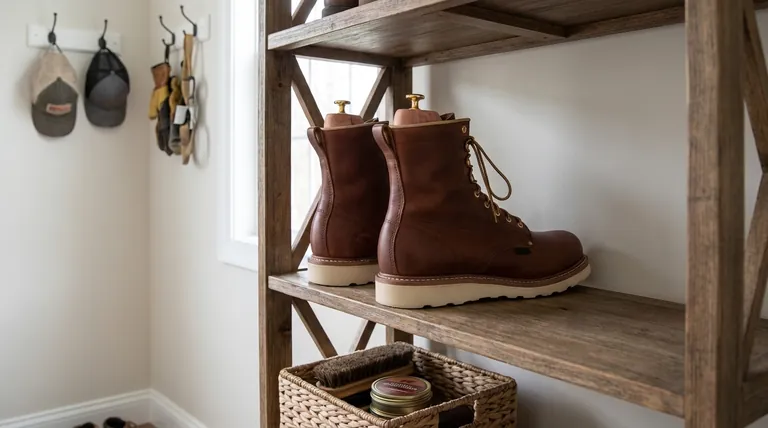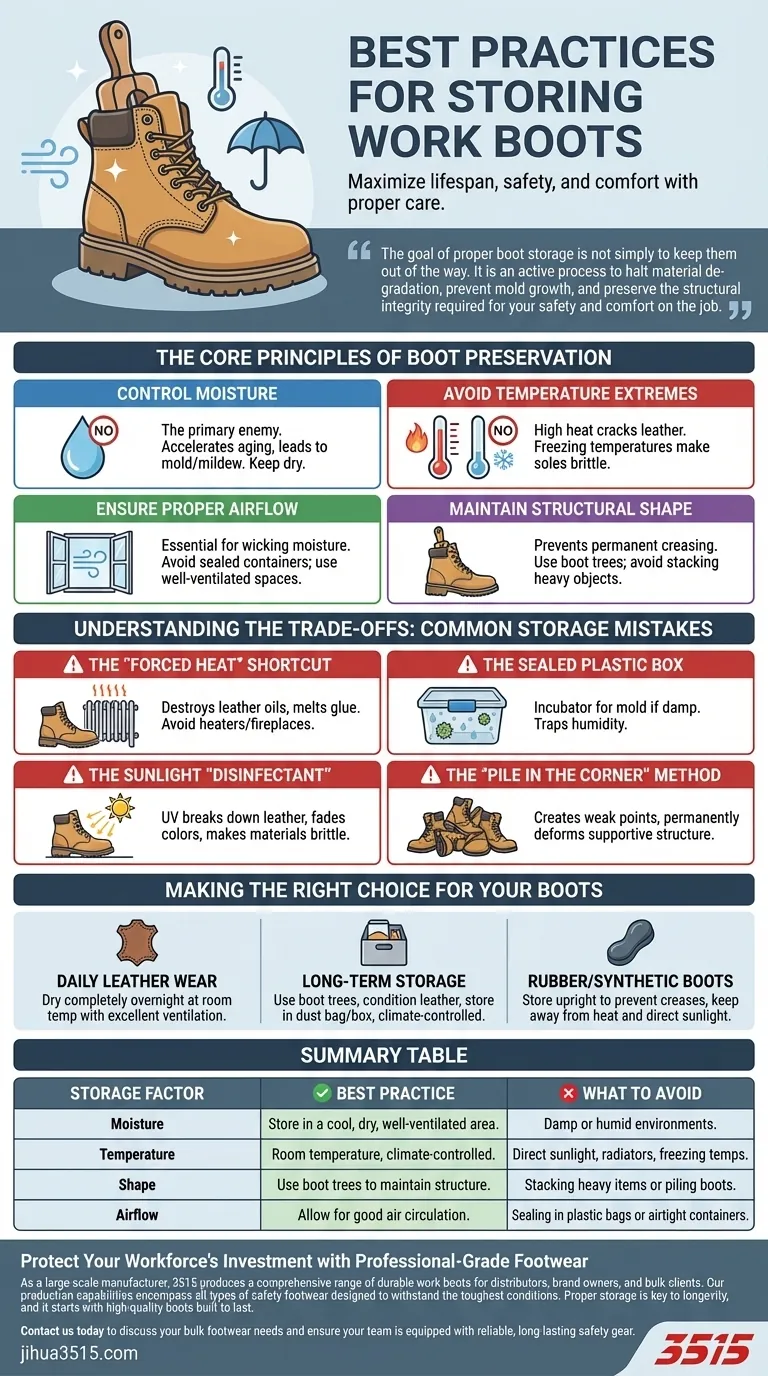Properly storing your work boots is a critical maintenance step that directly impacts their lifespan, safety, and comfort. The best practice is to always keep them in a cool, dry, and well-ventilated area away from direct sunlight or artificial heat sources. Before storing, ensure they are clean and completely dry, using boot trees to help maintain their structural shape.
The goal of proper boot storage is not simply to keep them out of the way. It is an active process to halt material degradation, prevent mold growth, and preserve the structural integrity required for your safety and comfort on the job.

The Core Principles of Boot Preservation
Understanding why certain conditions are harmful is the key to extending the life of your investment. Every storage decision should be based on controlling the environment around your boots.
Control Moisture: The Primary Enemy
Moisture is the single most destructive element for stored boots. It accelerates the natural aging process of materials.
Damp conditions lead to the growth of mold and mildew, which can permanently damage leather and fabrics. Trapped moisture can also cause materials to become brittle or even disintegrate over time.
Avoid Temperature Extremes
Both high heat and freezing temperatures can cause irreversible damage.
Forced heat from a radiator or direct sunlight will dry out leather too quickly, causing it to crack and shrink. For rubber or synthetic boots, high heat can degrade the materials and weaken adhesives. Sub-zero temperatures can make soles brittle.
Ensure Proper Airflow
Good ventilation is essential for wicking away any residual moisture from a day's work.
Storing boots in a sealed container or a damp, stagnant closet traps humidity. A well-ventilated space, like an open rack in a mudroom or garage, allows air to circulate freely.
Maintain Structural Shape
The physical shape of your boot is critical to its function and comfort. Storing them improperly can cause permanent creasing and collapse.
Using boot trees is the ideal solution, as they maintain the boot's intended shape and can help absorb moisture. At a minimum, avoid stacking heavy objects on your boots or storing them crushed in a pile.
Understanding the Trade-offs: Common Storage Mistakes
Many common storage "shortcuts" actively shorten the lifespan of your boots. Understanding these pitfalls is crucial for avoiding costly damage.
The "Forced Heat" Shortcut
Placing wet boots next to a heater or fireplace seems efficient, but it's incredibly damaging. This rapid drying process destroys leather's natural oils and can melt the cement used in boot construction.
The Sealed Plastic Box
While a plastic bin protects from dust, it's a disaster if the boots are even slightly damp. A sealed, non-ventilated environment becomes an incubator for mold and accelerates the decomposition of sole materials.
The Sunlight "Disinfectant"
Leaving boots in the sun may seem like a good way to dry and air them out. However, the UV radiation breaks down leather, fades colors, and makes rubber and synthetic components brittle.
The "Pile in the Corner" Method
Tossing boots in a heap is the most common mistake. This creases the materials, especially around the ankle, creating weak points and permanently deforming the boot's supportive structure.
Making the Right Choice for Your Boots
Your storage strategy should adapt to your specific boots and how you use them.
- If you wear leather boots daily: Your primary focus is on drying them completely overnight at room temperature with excellent ventilation.
- If you store boots for the long term: Use boot trees to maintain shape, condition the leather before storing, and keep them in a dust bag or box in a climate-controlled area.
- If you primarily use rubber or synthetic boots: Ensure they are stored upright to prevent permanent creases and are kept away from any heat source or direct sunlight.
Treating storage as the final step of your workday ensures your boots are ready to protect you for years to come.
Summary Table:
| Storage Factor | Best Practice | What to Avoid |
|---|---|---|
| Moisture | Store in a cool, dry, well-ventilated area. | Damp or humid environments. |
| Temperature | Room temperature, climate-controlled. | Direct sunlight, radiators, freezing temps. |
| Shape | Use boot trees to maintain structure. | Stacking heavy items or piling boots. |
| Airflow | Allow for good air circulation. | Sealing in plastic bags or airtight containers. |
Protect Your Workforce's Investment with Professional-Grade Footwear
As a large-scale manufacturer, 3515 produces a comprehensive range of durable work boots for distributors, brand owners, and bulk clients. Our production capabilities encompass all types of safety footwear designed to withstand the toughest conditions. Proper storage is key to longevity, and it starts with high-quality boots built to last.
Contact us today to discuss your bulk footwear needs and ensure your team is equipped with reliable, long-lasting safety gear.
Visual Guide

Related Products
- Wholesale Durable Leather Work Boots | 8-Inch Goodyear Welt Manufacturer
- Customizable Anti-Smash Safety Boots for Wholesale & Private Label Manufacturing
- Wholesale Safety Footwear Manufacturer for Bulk & Custom OEM Orders
- Wholesale Durable 6-Inch Work Boots | Custom & Private Label Manufacturer
- Durable Goodyear Welt Leather Work Boots for Wholesale & Private Label
People Also Ask
- Why is manufacturer diversity and inclusion important in work boot design? For Superior Fit, Safety & Comfort
- How should new leather work boots be broken in? A Guide to Comfort and Durability
- What makes work boots durable? The 3 Key Factors for Long-Lasting Footwear
- What is the complete process for deep cleaning leather work boots? A Step-by-Step Guide to Preserve Your Investment
- What are the best practices for storing leather work boots? Preserve Your Investment for Years












